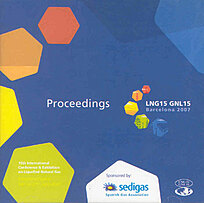
Comparative efficiency of natural gas sea transportation.
Author(s) : ODISHARIYA G., IZOTOV N.
Summary
The paper describes different variants of natural gas transportation: in liquefied state (liquefied natural gas - LNG); in gaseous state under high pressure (compressed natural gas - CNG); using adsorption and absorption processes; in the form of gas hydrate. According to the results of analysis of the above variants, one can conclude that each variant has its own scope of efficient application in terms of volume and distance of transportation. LNG variant is the most efficient for long-distance (over 3000 km) transportation of large volumes of gas. At present some companies have developed several CNG vessel projects, while other companies are planning to transport refrigerated (to -30/-40°C) compressed gas. By the authors' calculations, such technology is effective only for small (up to 3 bcm/y) volumes of gas supplied on short distances (up to 2000 km). The same situation is with the other types of gas transportation.
Details
- Original title: Comparative efficiency of natural gas sea transportation.
- Record ID : 2008-1134
- Languages: English
- Source: LNG 15. Proceedings of the 15th International Conference and Exhibition of Liquefied Natural Gas.
- Publication date: 2007/04/24
Links
See other articles from the proceedings (43)
See the conference proceedings
Indexing
-
Themes:
LNG and LPG;
Applications of liquified gases - Keywords: Comparison; Methane carrier; Sea transport; Process; LNG
-
Advanced LNG carrier with energy saving propuls...
- Author(s) : OHIRA H., SUETAKE Y., OKA M.
- Date : 2004/03/21
- Languages : English
- Source: LNG 14. Proceedings of the 14th international conference and exhibition of liquefied natural gas [CD-ROM].
View record
-
A NEW GENERATION OF LNG CARRIERS BASED ON A PRO...
- Author(s) : JEAN P., BOURGEOIS M.
- Date : 1984
- Languages : English
View record
-
The next generation of large LNG carriers for l...
- Author(s) : NOBLE P. G.
- Date : 2007/04/24
- Languages : English
- Source: LNG 15. Proceedings of the 15th International Conference and Exhibition of Liquefied Natural Gas.
View record
-
Domestic LNG supply system by pressure build-up...
- Author(s) : NAKANISHI K., IMAI H., WATANABE K., et al.
- Date : 2004/03/21
- Languages : English
- Source: LNG 14. Proceedings of the 14th international conference and exhibition of liquefied natural gas [CD-ROM].
View record
-
THERMODYNAMIC BEHAVIOUR OF LNG DURING MARINE TR...
- Author(s) : TANIGUCHI M., YONEYAMA T.
- Date : 1989/10/17
- Languages : English
View record
